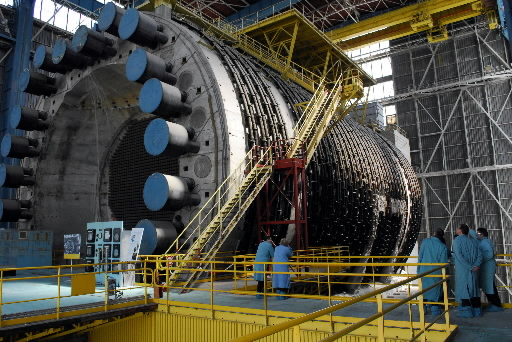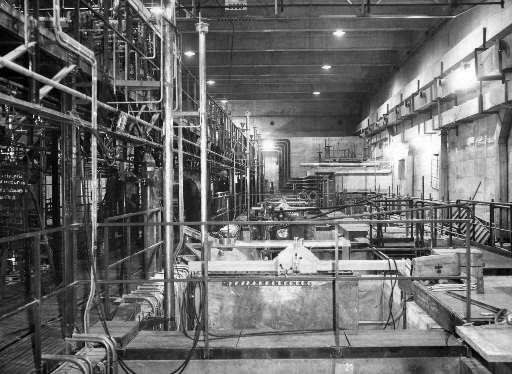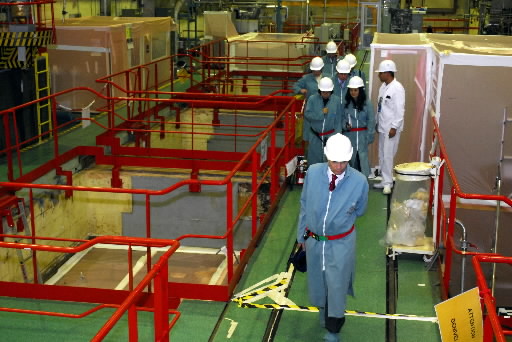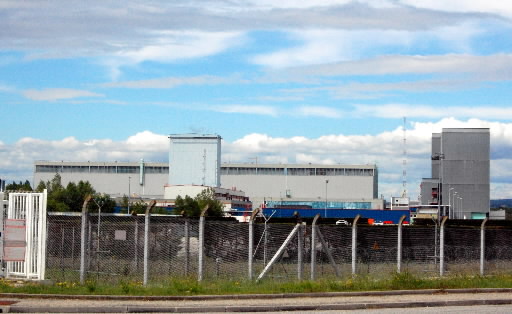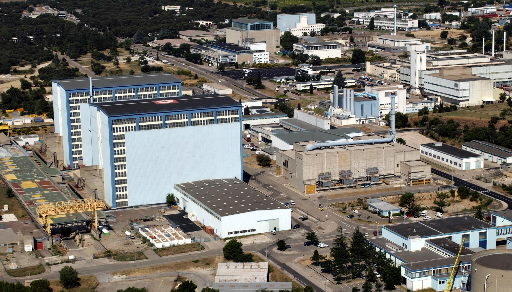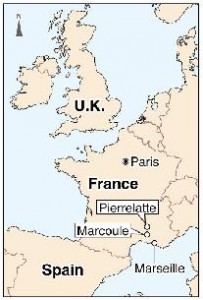Nuclear weapons can be eliminated: Part 5, Report on French nuclear facilities
Jul. 22, 2009
by Yumi Kanazaki, Staff Writer
Vast amounts of time and money required
I traveled to an area near Marseilles in southern France to report on the dismantling of nuclear development-related facilities used for uranium enrichment and the production of plutonium for military use. Although photography was not permitted inside the facilities, it was the first time operations were opened to a member of the news media, including news outlets in France. That may have been an effort to show that France was complying with its obligation to disarm under the terms of the Nuclear Non-proliferation Treaty (NPT). After the U.S. and Russia, France has more nuclear weapons than any other nuclear nation. At its nuclear facilities I looked into France’s reasoning with respect to its nuclear weapons.
I was first taken to a uranium enrichment facility called Pierrelatte, 150 kilometers from Marseilles on the Mediterranean Sea, where vineyards dot the landscape. An operating nuclear power plant is also located on the premises. Steam rose from two cooling towers.
“France is famous for three things: wine, cheese, and nuclear power,” boasted Francois Bugaut, in charge at the French Atomic Energy Commission (CEA).
I was allowed to see the so-called “low plant” where the initial stage of uranium enrichment was carried out. The plant, which was in operation from 1967 to 1996, enriched natural uranium with a uranium 235 content of 0.7 percent to 2 to 3 percent.
The plant’s compressors, gas diffusers and other equipment had been removed from the narrow 900-meter long building, and it was nearly empty. All that remained were stacks of white bags filled with various materials. “Most of the equipment has been removed, so we can allow people inside,” Mr. Bugaut said. He said the agency has exercised caution because even a leak of information on the configuration of the equipment could lead to the spread of the technology.
In Marcoule, an hour south by car, there is a mixed uranium/plutonium oxide (Mox) fuel fabrication plant that produces fuel for use in power generation. In one area of the sprawling 280-hectare premises, a nuclear reactor and reprocessing facility were being dismantled
The 50-meter tall building seemed like a perfectly ordinary iron works. But once inside the sight of the enormous cylindrical reactor, with a diameter of 20 meters and a length of 34 meters, was overwhelming. It is one of three graphite-moderated reactors that were in operation from the 1950s through the 1980s. It could stockpile weapons-grade plutonium while generating power. It used to transmit power to the nearby city of Avignon, supplying enough power for 100,000 people.
The cooling apparatus and heat exchanger had already been removed, but dismantling of the reactor itself has been postponed until 2020 because a revision in the law requires that a new facility for the disposal of high-level radioactive waste must be created. In particular, the graphite inside the reactor is highly radioactive and must be handled with care.
Within the grounds of the facility, there is also a plant, known as UP1, for the extraction of plutonium from the spent fuel used in the graphite reactor. The first reprocessing facility in France, it was in operation until 1997.
Highly contaminated parts are being removed by remote manipulation and cleaned up. By the time it is complete in 2040, the dismantling of UP1 will cost an estimated 5.6 billion euros (756 billion yen).
In addition to the dismantling, 500 million euros (67.5 billion yen) will be spent to dismantle the three graphite reactors and another 600 million euros (81 billion yen) will be spent on the uranium enrichment facility at Pierrelatte. A vast amount of time and money will be spent to clean up after France’s nuclear weapons development.
Among the five major nations that possess nuclear weapons, France has been the most active in dismantling and closing facilities that were used in the development and manufacture of nuclear weapons. Its efforts can be seen as representing a progressive stance toward nuclear disarmament.
But when an official was asked why the production of highly enriched uranium, plutonium and other fissionable materials for use in nuclear weapons was halted, the reply was, “Because we’ve stockpiled enough, though I can’t say how much we have.”
France, which developed its nuclear program for both civilian use and military purposes, conducted a nuclear test in the South Pacific in January 1996. Immediately afterwards it declared that it would halt its nuclear testing. The following month it announced the suspension of its production of plutonium and hammered out a plan for the dismantling of its nuclear facilities and the closing of testing grounds. Granting permission for the Chugoku Shimbun to see these facilities was part of those efforts.
After a long standoff at the Geneva Conference on Disarmament, in May it was finally decided to resume negotiations on the conclusion of a treaty regarding the cut-off of the production of fissionable materials for nuclear weapons use. The negotiations are expected to focus on whether or not regulations will be applied to materials that countries have stockpiled, and the stance of France and other nuclear nations will inevitably be questioned.
Patrice Bouveret, 53, of the French Centre for Research on Peace and Conflicts, an anti-nuclear group based in Lyon, said, “We must not forget the role France played in the proliferation of nuclear weapons.” The reactor at Marcoule that the Chugoku Shimbun was not allowed to see is believed to be identical to the one used in the manufacture of Israel’s nuclear weapons at Dimona.
France’s efforts to contribute to nuclear disarmament are praiseworthy, but as a country that possesses nuclear weapons its assertions are unlikely to find support among other nations. How can the negative legacy of nuclear weapons development be eradicated? The global community’s handling of this matter through the cutoff treaty and other matters will be subject to scrutiny.
(Originally published on June 26, 2009)
To comment on this article, please click the link below. Comments will be moderated and posted in a timely fashion. Comments may also appear in the Chugoku Shimbun newspaper.
Vast amounts of time and money required
I traveled to an area near Marseilles in southern France to report on the dismantling of nuclear development-related facilities used for uranium enrichment and the production of plutonium for military use. Although photography was not permitted inside the facilities, it was the first time operations were opened to a member of the news media, including news outlets in France. That may have been an effort to show that France was complying with its obligation to disarm under the terms of the Nuclear Non-proliferation Treaty (NPT). After the U.S. and Russia, France has more nuclear weapons than any other nuclear nation. At its nuclear facilities I looked into France’s reasoning with respect to its nuclear weapons.
I was first taken to a uranium enrichment facility called Pierrelatte, 150 kilometers from Marseilles on the Mediterranean Sea, where vineyards dot the landscape. An operating nuclear power plant is also located on the premises. Steam rose from two cooling towers.
“France is famous for three things: wine, cheese, and nuclear power,” boasted Francois Bugaut, in charge at the French Atomic Energy Commission (CEA).
I was allowed to see the so-called “low plant” where the initial stage of uranium enrichment was carried out. The plant, which was in operation from 1967 to 1996, enriched natural uranium with a uranium 235 content of 0.7 percent to 2 to 3 percent.
The plant’s compressors, gas diffusers and other equipment had been removed from the narrow 900-meter long building, and it was nearly empty. All that remained were stacks of white bags filled with various materials. “Most of the equipment has been removed, so we can allow people inside,” Mr. Bugaut said. He said the agency has exercised caution because even a leak of information on the configuration of the equipment could lead to the spread of the technology.
In Marcoule, an hour south by car, there is a mixed uranium/plutonium oxide (Mox) fuel fabrication plant that produces fuel for use in power generation. In one area of the sprawling 280-hectare premises, a nuclear reactor and reprocessing facility were being dismantled
The 50-meter tall building seemed like a perfectly ordinary iron works. But once inside the sight of the enormous cylindrical reactor, with a diameter of 20 meters and a length of 34 meters, was overwhelming. It is one of three graphite-moderated reactors that were in operation from the 1950s through the 1980s. It could stockpile weapons-grade plutonium while generating power. It used to transmit power to the nearby city of Avignon, supplying enough power for 100,000 people.
The cooling apparatus and heat exchanger had already been removed, but dismantling of the reactor itself has been postponed until 2020 because a revision in the law requires that a new facility for the disposal of high-level radioactive waste must be created. In particular, the graphite inside the reactor is highly radioactive and must be handled with care.
Within the grounds of the facility, there is also a plant, known as UP1, for the extraction of plutonium from the spent fuel used in the graphite reactor. The first reprocessing facility in France, it was in operation until 1997.
Highly contaminated parts are being removed by remote manipulation and cleaned up. By the time it is complete in 2040, the dismantling of UP1 will cost an estimated 5.6 billion euros (756 billion yen).
In addition to the dismantling, 500 million euros (67.5 billion yen) will be spent to dismantle the three graphite reactors and another 600 million euros (81 billion yen) will be spent on the uranium enrichment facility at Pierrelatte. A vast amount of time and money will be spent to clean up after France’s nuclear weapons development.
Comment: Will there be restrictions?
Among the five major nations that possess nuclear weapons, France has been the most active in dismantling and closing facilities that were used in the development and manufacture of nuclear weapons. Its efforts can be seen as representing a progressive stance toward nuclear disarmament.
But when an official was asked why the production of highly enriched uranium, plutonium and other fissionable materials for use in nuclear weapons was halted, the reply was, “Because we’ve stockpiled enough, though I can’t say how much we have.”
France, which developed its nuclear program for both civilian use and military purposes, conducted a nuclear test in the South Pacific in January 1996. Immediately afterwards it declared that it would halt its nuclear testing. The following month it announced the suspension of its production of plutonium and hammered out a plan for the dismantling of its nuclear facilities and the closing of testing grounds. Granting permission for the Chugoku Shimbun to see these facilities was part of those efforts.
After a long standoff at the Geneva Conference on Disarmament, in May it was finally decided to resume negotiations on the conclusion of a treaty regarding the cut-off of the production of fissionable materials for nuclear weapons use. The negotiations are expected to focus on whether or not regulations will be applied to materials that countries have stockpiled, and the stance of France and other nuclear nations will inevitably be questioned.
Patrice Bouveret, 53, of the French Centre for Research on Peace and Conflicts, an anti-nuclear group based in Lyon, said, “We must not forget the role France played in the proliferation of nuclear weapons.” The reactor at Marcoule that the Chugoku Shimbun was not allowed to see is believed to be identical to the one used in the manufacture of Israel’s nuclear weapons at Dimona.
France’s efforts to contribute to nuclear disarmament are praiseworthy, but as a country that possesses nuclear weapons its assertions are unlikely to find support among other nations. How can the negative legacy of nuclear weapons development be eradicated? The global community’s handling of this matter through the cutoff treaty and other matters will be subject to scrutiny.
(Originally published on June 26, 2009)
To comment on this article, please click the link below. Comments will be moderated and posted in a timely fashion. Comments may also appear in the Chugoku Shimbun newspaper.

